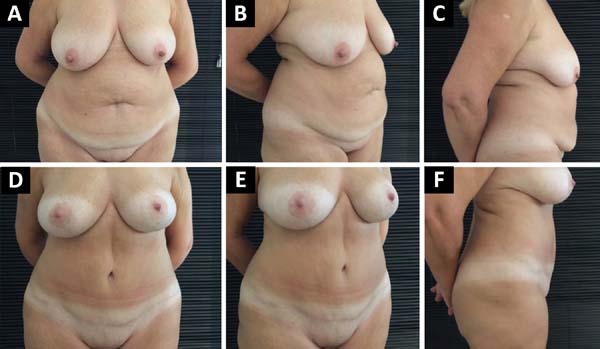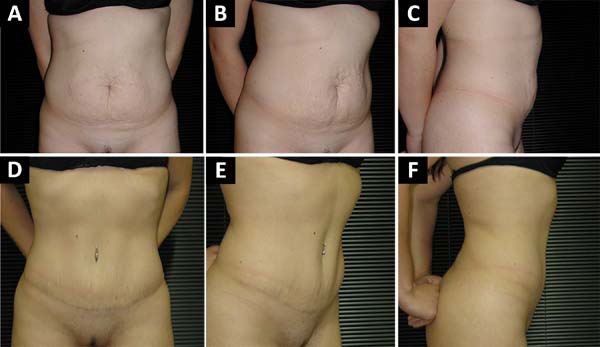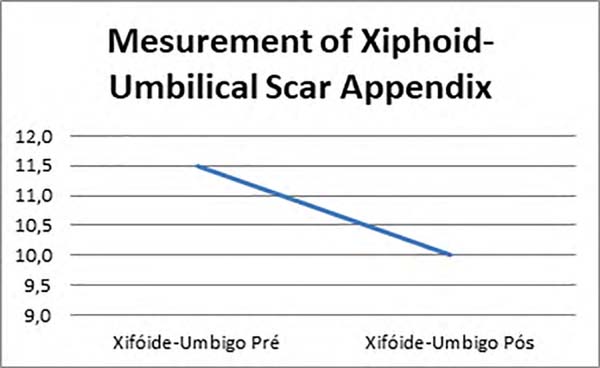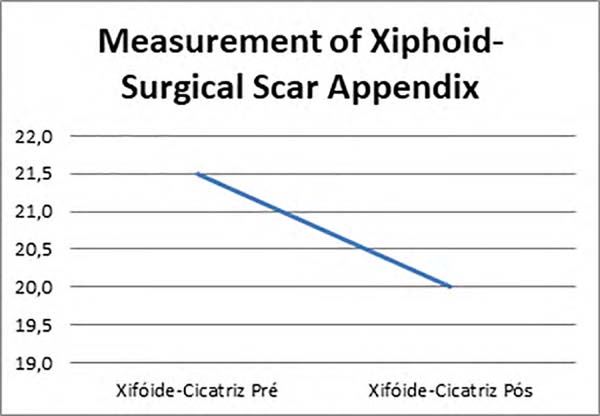INTRODUCTION
Abdominal dermolipectomy, also known as abdominoplasty, has been performed for decades,
and it has gradually evolved to the more elaborate techniques currently in use.
From the surgical point of view, there has been a considerable evolution with respect
to scar extension and dermoadipose flap detachment.
In the late 1970s, reduced incision abdominoplasty was introduced, which provided
good results in selected cases. However, changes in the supraumbilical region could
not be properly corrected with this technique, and this limitation with excess skin
was evident when the patient sat, leading to patient and doctor dissatisfaction in
most cases.
In the 1980s, the introduction of liposuction associated with abdominal plastic surgery
yielded better results. However, there were considerable complication rates, especially
with seromas1.
n 1988, Baroudi et al. published a paper describing the use of adhesion points between
the dermoadipose flap and the anterior rectus abdominis sheath to reduce dead space
and consequent seroma formation, a frequent complication previously observed due to
extensive detachment in the classic abdominoplasty2. In 1999, Avelar et al.3 described the technique of mini-tummy tuck without flap detachment in the lower abdominal
portion. In 2001, Saldanha4 introduced the lipoabdominoplasty technique with preservation of the perforating
vessels, showing a significant reduction in flap necrosis rates and introducing a
new direction in abdominal plastic surgery. Lipoabdominoplasty with liposuction reduces
supraumbilical dermoadipose flap detachment and preserves blood circulation in the
flap3.
Abdominoplasty is based on the variable length of detachment of the fasciocutaneous
layer of the abdomen encompassing the xipho-pubic region, flank region, and costal
arches, with subsequent resection of the dermoadipose panicle excess and lowering
of the flap. The tension generated by the flap approach towards the lower incision
seems to be responsible for scar enlargement, tendency of more cranial scar positioning,
suture dehiscence, and necrosis of the lower flap portions4.
Since 2005, lipoabdominoplasty has been the preferred technique for treatment of abdominal
deformities at the Santa Casa de Misericórdia Plastic Surgery Service of Porto Alegre/Federal
University of Health Sciences of Porto Alegre. This consists of performing epigastrium
and flank liposuction with reduced dermoadipose flap detachment. During the synthesis,
Baroudi adhesion points are made to reducing the dead space and facilitate the flap
descent associated with better positioning. The number of points executed does not
follow any predetermined rigid standard and are performed as needed5.
Although several studies have been conducted on the use of Baroudi points for seroma
reduction, limited data are available on the use of Baroudi adhesion points for scar
tension reduction and subsequent improvement in its appearance.
Therefore, the present study proposed to demonstrate a probable correlation between
Baroudi adhesion points and flap tension force, verifying the positioning, maintenance,
and scar quality after abdominoplasty by using these points6.
OBJECTIVE
The main objective of the present study was to quantify the reduction of scar tension
after abdominoplasty using Baroudi adhesion points.
Additionally, the transoperatory measurements of the distance from the sternal xiphoid
appendix to the umbilical scar before and after the execution of Baroudi adhesion
points was compared to correlate these measurements with the healing quality.
METHODS
Inclusion criteria
Female non-smoking patients aged 18-60 years and with a body mass index (BMI) of <28
kg/m2 who underwent lipoabdominoplasty at the Santa Casa de Misericórdia Plastic Service
of Porto Alegre from January to April 2019 were included.
Exclusion Criteria
Patients who did not agree to participate in the study were excluded.
Design
This was a prospective observational study.
Methods
All included patients underwent standardized pre-, trans-, and postoperative care.
The transoperatory measurements of distance from the sternal xiphoid appendix to the
umbilical scar and from the pre-xiphoid to the post-xiphoid scar before and after
execution of Baroudi’s adhesion points were measured. The difference between these
two measurements was evaluated in the results.
Consecutive prospective statistical analysis of the data was performed using Excel
software®.
The present study was not interventional. The surgical procedure for abdominal dermolipectomy
was performed in each patient as indicated by the case after the consent form and
authorization for surgery were obtained. Lipoabdominoplasty was used as the surgical
technique, and the study included patients who met the inclusion criteria. All standards
issued by the National Health Agency were strictly followed. Patients and/or guardians
received proper guidance on the procedures performed.
The Santa Casa de Misericórdia Plastic Surgery Service of Porto Alegre/Federal University
of Health Sciences of Porto Alegre is committed to maintain confidentiality of data
contained in the medical records, ensuring that patients are not identified during
the course of the research.
RESULTS
Eighteen patients were included in the study, and their transoperatory measurements
are listed in Table 1.
Table 1 - Pre- and postoperative measurements of Baroudi adhesion points in centimeters
| Patient |
Pre-Xiphoid Umbilical |
Post-Xiphoid Umbilical |
Pre-Xiphoid Scar |
Post-Xiphoid Scar |
| 1 |
10.0cm |
9.0 cm |
20.0 cm |
19.0 cm |
| 2 |
10.4cm |
8.9 cm |
20.4 cm |
18.9 cm |
| 3 |
11.8 cm |
9.8 cm |
21.8 cm |
19.8 cm |
| 4 |
10.4 cm |
8.4 cm |
20.4 cm |
18.4 cm |
| 5 |
12.2 cm |
10.7 cm |
22.2 cm |
20.7 cm |
| 6 |
10.8 cm |
9.8 cm |
20.8 cm |
19.8 cm |
| 7 |
12.6 cm |
11.6 cm |
22.6 cm |
21.6 cm |
| 8 |
11.2 cm |
9.7 cm |
21.2 cm |
19.7 cm |
| 9 |
13.0 cm |
11.0 cm |
23.0 cm |
21.0 cm |
| 10 |
11.6 cm |
9.6 cm |
21.6 cm |
19.6 cm |
| 11 |
13.2 cm |
11.7 cm |
23.2 cm |
21.7 cm |
| 12 |
11.4 cm |
10.4 cm |
21.4 cm |
20.4 cm |
| 13 |
12.8 cm |
11.8 cm |
22.8 cm |
21.8 cm |
| 14 |
11.0 cm |
9.5 cm |
21.0 cm |
19.5 cm |
| 15 |
12.4 cm |
10.4 cm |
22.4 cm |
20.4 cm |
| 16 |
10.6 cm |
8.6 cm |
20.6 cm |
18.6 cm |
| 17 |
12.0 cm |
10.5 cm |
22.0 cm |
20.5 cm |
| 18 |
10.2 cm |
9.2 cm |
20.2 cm |
19.2 cm |
| Mean |
11.5 cm |
10.0 cm |
21.5 cm |
20.0 cm |
Table 1 - Pre- and postoperative measurements of Baroudi adhesion points in centimeters
A decreased in the distance of the xiphoid-umbilical scar appendix and the xiphoid-surgical
scar appendix (Figures 1, 2 and 3) was observed after the use of Baroudi adhesion points (Figures 4 and 5).
Figure 1 - A-C Preoperative; D-F Postoperative 12 months.
Figure 1 - A-C Preoperative; D-F Postoperative 12 months.
Figure 2 - A-C Preoperative; D-F Postoperative 12 months.
Figure 2 - A-C Preoperative; D-F Postoperative 12 months.
Figure 3 - A-C Preoperative; D-F Postoperative 12 months.
Figure 3 - A-C Preoperative; D-F Postoperative 12 months.
Figure 3 - Variation in the measurement of the xiphoid-umbilical scar appendix.
Figure 3 - Variation in the measurement of the xiphoid-umbilical scar appendix.
Figure 4 - Variation in the measurement of the xiphoid-surgical scar appendix
Figure 4 - Variation in the measurement of the xiphoid-surgical scar appendix
DISCUSSION
There have been complications associated with the evolution of abdominoplasty, especially
for seroma and flap necrosis, which vary according to the case. The main cause of
complications is the large displacement in classical surgery that sliced lymphatic
and perforating vessels. To minimize such complications, various techniques were proposed
to reduce dissections. Baroudi’s adhesion points were undoubtedly a simple and efficient
solution to a frequent and sometimes complex problem. In abdominoplasty, the adhesion
technique initially described by Baroudi and Ferreira to detached flaps is an effective
method to eliminate seroma and use a suction drain7,8. Its benefits were reiterated by Nahas et al. in 20079, Pollock et al. in 200010, and Roje et al. in 200611.
Based on our study results, it was possible to refute the null hypothesis that there
is no significant difference in distances with and without the use of Baroudi adhesion
points.
The reduction in the distance of the xiphoid-umbilical scar appendix and xiphoid-surgical
scar appendix was verified after the execution of Baroudi suture (mean 1.5 cm), assuming
a reduction in scar tension and a reduction in the surgical scar distance of the xiphoid
appendix at the expense of narrowing the distance between it and the umbilical scar.
Follow-up of these patients is necessary to verify the long-term postoperative scar
evolution.
CONCLUSION
There was a decrease in the xiphoid-umbilical scar and xiphoid-abdominal scar distances
after the Baroudi stitches on the abdominal flap, showing a lower tension on the scar
after using these adhesion points. Further studies should be conducted to evaluate
how these measures behave in the late postoperative period until scar maturation and
if they actually correlate with a better-quality scar.
COLLABORATIONS
|
TMS
|
Statistical analysis, design and study design.
|
|
CB
|
Statistical analysis, design and study design.
|
|
NS
|
Writing of the manucrist or critical revision of its content.
|
|
PBE
|
Writing of the manucrist or critical revision of its content.
|
REFERENCES
1. Matarasso A, Swift RW, Rankin M. Abdominoplasty and abdominal contour surgery: a national
plastic surgery survey. Plast Reconstr Surg. 2006 May;117(6):1797-1808. DOI: https://doi.org/10.1097/01.prs.0000209918.55752.f3
2. Baroudi R, Ferreira CA. Seroma: how to avoid it and how to treat it. Aesthet Surg
J. 1988 Nov/Dec;18(6):439-41. DOI: https://doi.org/10.1016/S1090-820X(98)70073-1
3. Zimman OA, Butto CD, Ahualli PE. Frequency of seroma in abdominal lipectomies. Plast
Reconstr Surg. 2001 Oct;108(5):1449-51. PMID: 11604669 DOI: https://doi.org/10.1097/00006534-200110000-00071
4. Nahas FX, Ferreira LM, Ghelfond C. Does Quilting Suture Prevent Seroma in Abdominoplasty?.
Plast Reconstr Surg. 2007 Mar;119(3):1060-64;discussion:1065-6. DOI: https://doi.org/10.1097/01.prs.0000242493.11655.68
5. Andrades P, Prado A, Danilla S, et al. Progressive tension sutures in the prevention
of postabdominoplasty seroma: a prospective, randomized, doublo-blind clinical trial.
Plast Reconstr Surg. 2007 Sep;120(4):935-46;discussion:947-51. DOI: https://doi.org/10.1097/01.prs.0000253445.76991.de
6. Arantes HL, Rosique RG, Rosique MJ, Mélega JM. The use of quilting suture in abdominoplasty
does not require aspiratory drainage for prevention of seroma. Aesthetic Plast Surg.
2010 Feb;34(1):102-4. DOI: https://doi.org/10.1007/s00266-009-9453-6
7. Baroudi R, Ferreira CA. Contouring the hip and the abdomen. Clin Plast Surg. 1996
Oct;23(4):551-72;discussion:572-3.
8. Baroudi R, Ferreira CA. Seroma: how to avoid it and how to treat it. Aesthetic Surg
J. 1998 Nov/Dec;18(6):439-41. DOI: https://doi.org/10.1016/S1090-820X(98)70073-1
9. Nahas FX, Ferreira LM, Ghelfond C. Does quilting suture prevent seroma in abdominoplasty?.
Plast Reconstr Surg. 2007;119(3):1060-6. DOI: https://doi.org/10.1097/01.prs.0000242493.11655.68
10. Pollock H, Pollock T. Progressive tension sutures: a technique to reduce local complications
in abdominoplasty. Plast Reconstr Surg. 2000 Jun;105(7):2583-8;discussion:2587-8.
11. Roje Z, Roje Z, Karanovic N, Utrobicic I. Abdominoplasty complications: a comprehensive
approach for the treatment of chronic seroma with pseudobursa. Aesthetic Plast Surg.
2006 Sep/Oct;30(5):611-5. DOI: https://doi.org/10.1007/s00266-004-0142-1
1. Santa Casa de Misericórdia de Porto Alegre, Porto Alegre, RS, Brazil.
2. Universidade Federal de Ciências da Saúde de Porto Alegre, Porto Alegre, RS, Brazil.
Corresponding author: Thiago Melo de Souza Rua Professor Annes Dias, 135, Centro Histórico, Porto Alegre, RS, Brasil. Zip Code:
90040-001. E-mail: thiagosouza.md@gmail.com
Article received: July 19, 2019.
Article accepted: September 01, 2019.
Conflicts of interest: none.



















